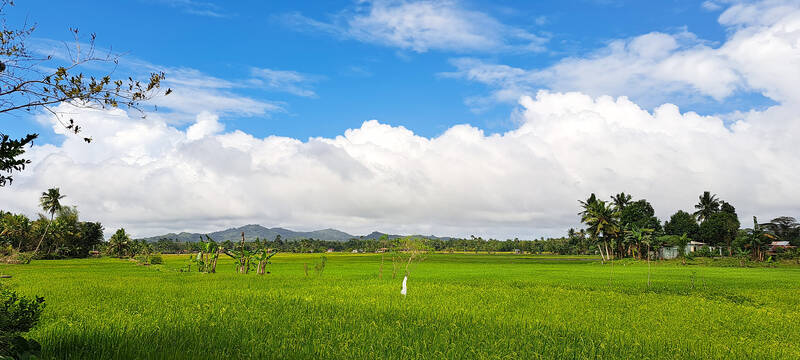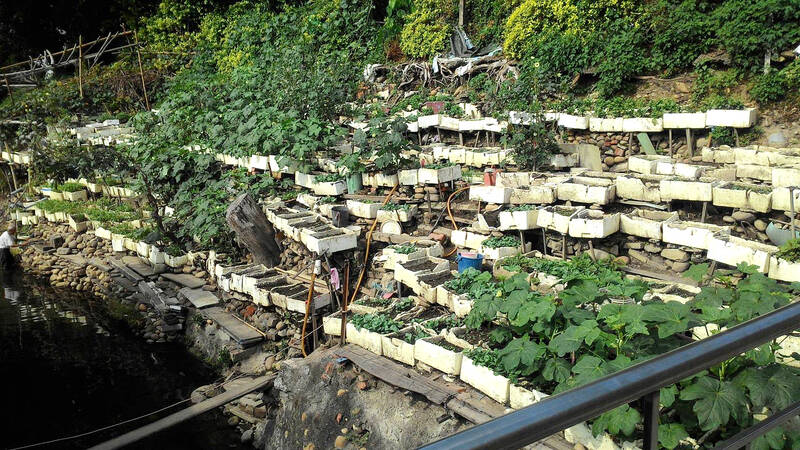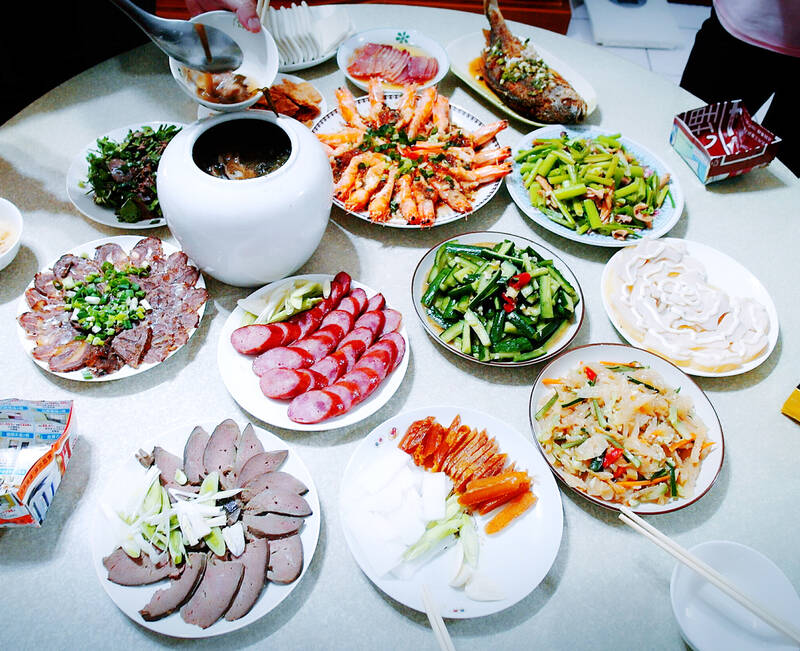The last couple of weeks I have been traveling across the island of Panay in the Philippines, visiting my wife’s family. Inevitably, I have spent a lot of time on the trip comparing the Philippines to Taiwan and contemplating the rich, ancient connections between them. I could wax eloquent on politics or history, but today I’m going to talk about that most lowly of food items, the humble green.
That’s what I miss the most whenever I leave Taiwan, and of all the nations around Taiwan, the Philippines presents the sharpest contrast on this topic. Our benighted, myopic tourism bureau may pointlessly pimp expensive foods to well-heeled audiences who can easily obtain them in their home countries, but to my mind, no place does greens so deliciously, and in such variety and abundance, as Taiwan. We live in a food paradise made of greens. In the endless debates on the Internet over what the best Taiwanese food is, nobody ever mentions greens, but they should.
WHERE ARE THE GREENS?

Photo: Michael Turton
Walking around in the market in my wife’s small hometown really drives home this point. Her largely agricultural home district has a population of 40,000, but in its expansive market only western cabbage, Chinese cabbage and water spinach are plentiful. There are other greens, like bok choy, in small amounts. The same dearth was evident in the supermarkets and wet markets of Iloilo, the large old trading city on the southern end of Panay, which houses roughly 450,000.
There are greens around, the trick is getting someone to serve them to you.
My father-in-law grows acres of rice, along with rambutans, calimansi, papaya, wax apples, mangoes, avocadoes, soursop and lanzones, but he has only a tiny plot of water spinach. He also grows sweet potatoes and cassava, and the family eats their leaves. Sometimes.

Photo courtesy of Hsieh Shu-ya
In the restaurants one searches in vain for a simple plate of fresh stir-fried greens, indeed for any kind of vegetable. I did have some scraggly water spinach at one place, boiled to tasteless parchment. Sometimes they offer chop suey, a melange of overcooked vegetables in mystery sauce, but that’s it. Filipinos are carnivores who like their meat with a mountainous side of rice. No one loves barbecued belly pork more than I, but I like it with a side of greens.
I had the good fortune to attend a local wedding. Bride and groom were both blood relatives of my wife, and the phrase “I’d like you to meet my cousin…” sufficed to introduce me to everyone in the church. At the reception several dishes were served, all meat except the spring rolls, which may have been contaminated with a forlorn scrap of carrot, but I will not swear to it.
Craving greens, as I always do when I leave Taiwan, I went to one of the more well known Chinese restaurants in Iloilo, with a menu in both English and Chinese, but stir-fried greens were not on offer, though they had a few vegetable dishes.

Photo courtesy of the Taichung Community Society
HEALTHY GREENS
In Taiwan we take for granted the small restaurant proprietor’s pursed lips and frown as she considers what kind she bought that morning when we ask what greens she has: Cabbage? Water spinach? Sweet potato leaves? Oh yeah, got them all.
At the wedding party one of my in-laws indicated the men at the table with a sweep of his hand.

Photo courtesy of Ministry of Health and Welfare
“All of them have hypertension,” he said. “It’s no wonder,” I replied. “Look at this food.”
A table full of nothing but meat lay in front of us, ominously unhealthy. He nodded.
One reason Taiwan’s greens are so delightful and healthful is that Taiwanese prepare them in non-tropical oils, as one review in July last year of studies on Taiwan’s food consumption patterns in the journal Nutrients points out. Indeed, a 2011 article by the same lead author that compares diet surveys from the mid 1990s and mid 2000s notes that the sedentary lifestyle and increased consumption of processed foods has been partially offset by increased consumption of vegetable oils, among other positive trends.
Yet, as the Taipei Times reported in 2012, our leafy vegetables are overloaded with chemical fertilizer residues.
Is our diet really better? Given the meat-centric diet in the Philippines with pork at its core, it is somewhat surprising to learn that the nation with the highest per capita pork consumption in Asia is Taiwan. According to a 2017 pork meat market survey from Flanders Investment and Trade of the Belgian Office in Taiwan, Taiwanese consume 35-40 kilos of pork per capita, more than twice the per capita consumption of Filipinos.
It’s no wonder then that when I order one meat dish and three plates of veggies at a restaurant the waitress sometimes gives me an anxious look, since clearly I have the proper ratio of meat to vegetables reversed.
Why are Filipinos such meat lovers? Many commentators trace it back to the high status of pigs among the pre-colonial Austronesian peoples of the islands. When the Chinese traders arrived they brought their love of pork, the same love the settlers brought to Taiwan. Another suggestion is that vegetables are perceived as poverty foods.
Which population is healthier? Taiwanese live long, but major issues loom. According to the International Diabetes Federation (IDF), in 2021 the age-adjusted prevalence of diabetes in people over 20 was higher in Taiwan (9.7 percent) than in Philippines (7.1 percent). That could well be an artifact of Taiwan’s better medical reporting, since that same dataset shows a much higher incidence of unreported cases in the Philippines, but it is indicative. The two populations also suffer from the global obesity epidemic.
I often speculate on might-have-beens, but it is interesting to imagine what might have happened foodwise if the Spanish had eventually incorporated Taiwan into their Philippines colony, or if Ming warlord Cheng Cheng-kung (鄭成功, also known as Koxinga) had lived long enough to grab Manila and rule it for a long period. Perhaps it would be barbecue everywhere.
But luckily we have greens. You can have your bubble tea and twice-cooked pork and Ding Tai Fung. They can’t touch Taiwan’s best dish: a perfectly cooked plate of leafy greens stir-fried with garlic and served bright and crispy by boss auntie, who is already ignoring you to move on to the next customer.
Notes from Central Taiwan is a column written by long-term resident Michael Turton, who provides incisive commentary informed by three decades of living in and writing about his adoptive country. The views expressed here are his own.

Oct. 27 to Nov. 2 Over a breakfast of soymilk and fried dough costing less than NT$400, seven officials and engineers agreed on a NT$400 million plan — unaware that it would mark the beginning of Taiwan’s semiconductor empire. It was a cold February morning in 1974. Gathered at the unassuming shop were Economics minister Sun Yun-hsuan (孫運璿), director-general of Transportation and Communications Kao Yu-shu (高玉樹), Industrial Technology Research Institute (ITRI) president Wang Chao-chen (王兆振), Telecommunications Laboratories director Kang Pao-huang (康寶煌), Executive Yuan secretary-general Fei Hua (費驊), director-general of Telecommunications Fang Hsien-chi (方賢齊) and Radio Corporation of America (RCA) Laboratories director Pan

President William Lai (賴清德) has championed Taiwan as an “AI Island” — an artificial intelligence (AI) hub powering the global tech economy. But without major shifts in talent, funding and strategic direction, this vision risks becoming a static fortress: indispensable, yet immobile and vulnerable. It’s time to reframe Taiwan’s ambition. Time to move from a resource-rich AI island to an AI Armada. Why change metaphors? Because choosing the right metaphor shapes both understanding and strategy. The “AI Island” frames our national ambition as a static fortress that, while valuable, is still vulnerable and reactive. Shifting our metaphor to an “AI Armada”
The consensus on the Chinese Nationalist Party (KMT) chair race is that Cheng Li-wun (鄭麗文) ran a populist, ideological back-to-basics campaign and soundly defeated former Taipei mayor Hau Lung-bin (郝龍斌), the candidate backed by the big institutional players. Cheng tapped into a wave of popular enthusiasm within the KMT, while the institutional players’ get-out-the-vote abilities fell flat, suggesting their power has weakened significantly. Yet, a closer look at the race paints a more complicated picture, raising questions about some analysts’ conclusions, including my own. TURNOUT Here is a surprising statistic: Turnout was 130,678, or 39.46 percent of the 331,145 eligible party

The older you get, and the more obsessed with your health, the more it feels as if life comes down to numbers: how many more years you can expect; your lean body mass; your percentage of visceral fat; how dense your bones are; how many kilos you can squat; how long you can deadhang; how often you still do it; your levels of LDL and HDL cholesterol; your resting heart rate; your overnight blood oxygen level; how quickly you can run; how many steps you do in a day; how many hours you sleep; how fast you are shrinking; how